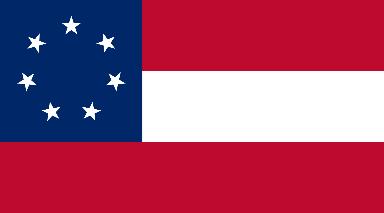CONFEDERATE STATES OF AMERICA FINANCIAL INSTRUMENTS
National Government Currency
First National Flag and the Great Seal of the Confederate States of America
The first Confederate banknotess were issued in Montgomery, Alabama, the then-capital of the Confederate States of America (CSA). The CSA for formally proclaimed in February 1862 by the seven States that had seceded from the United States following the election of Lincoln. The capital was moved to Richmond Virginia in May 1861. Meanwhile four other states joined the Confederacy and two other States had both Confederate and Union government factions (Kentucky and Missouri). Maryland had pro-secession feelings but Lincoln arrested or barred the strongest pro-Southern State legislators from their constitutional duties to prevent enactment of a secession declaration. Maryland did provide many units that fought with the Confederacy against the Federals. In addition there was the Territory of Arizona encompassing much of today's States of New Mexico and Arizona.
After secession, the seceding States called for the US to abandon their military bases in their territories. In April 1861, Lincoln sent a replenishment ship to Fort Sumter in the harbor of Charleston South Carolina. This caused the bombardment of Fort Sumter and launched the War for Southern Independence. These bonds were issued to support the Confederate Government and for defense of their territories from Northern aggression.
The first four notes were issued in Montgomery but they are exceedingly rare (and expensive). All subsequent notes were issued under the Richmond government.
Confederate banknotes were first cataloged by William West Bradbeer in 1915 in his Confederate and Southern State Currency and were published more extensively by Grover Criswell who issued his Confederate and Southern States Currency first edition in 1957. There has been several editions published since then. Criswell set up Type numbers as well as catalog numbers. Many of the motes have several subtypes that Criswell has cataloged. George Cuhaj came out with a more recent catalog that provides more detailed background information than Criswell but the note subtypes are not listed as in Criswell. Pierre Fricke has authored a very comprehensive study of CSA banknotes, Collecting Confederate Paper Money, It is by far the best reference that I know of for these banknotes.
For years there was a saying "Save your Confederate money, the South will rise again." With the current Federal misgovernment, that might be the salvation of the American Republic if the good people of this country rebelled against Washington DC. Nonetheless, Congress addressed Confederate currency. The Fourteenth Amendment to the US Constitution enacted on 9 July 1868 forbade recognition of Confederate debt:
"But neither the United States nor any State shall assume or pay any debt or obligation incurred in aid of insurrection or rebellion against the United States, ... but all such debts, obligations and claims shall be held illegal and void."
Most of these notes were issued uniface though some of the later notes did have engraved backs. Many of these notes were interest bearing and some have been stamped on the backs with Interest Paid handstamps denoting the date and the paying office identity.
Catalog numbers refer to Bradbeer and Criswell's series on Confederate and Southern States issues are used as the Type numbers and respective catalog numbers. "PF" numbers reference those subtypes identified by Pierre Fricke.
Bradbeer had an excellent history of the CSA finances published in 1915. I include it here because of the great source of information:
HISTORICAL & FINANCIAL.
The Confederate States of America, established a provisional government and Capitol at Montgomery, Alabama, on February 9th, 1861. Jefferson Davis, of Mississippi; and Alexander H. Stephens, of Georgia, were elected President and Vice-President, respectively. The daughter of Robert Tyler raised the Confederate Flag over the Montgomery Capitol, on the day of Abraham Lincoln’s inauguration as President of the United States.
The Confederate Cabinet Officers Were:
Robert Toombs, of Georgia, Secretary of State.
Judah P. Benjamin, of Louisiana, Attorney General.
Christopher G. Memminger, of South Carolina, Secretary of the Treasury.
Stephen R. Mallory, of Florida, Secretary of the Navy
Henry T. Ellett, of Mississippi, Post-Master General.]
Leroy P. Walker, of Alabama, Secretary of War.
The provisional Congress (Session, Feb. 4th to Mar. 6th) authorized on February 28th a “Fifteen Million Loan” to be secured by an issue of bonds, payable “on the first day of September 1871” at eight per cent, interest, per annum. In order to insure payment of the bonds, Congress enacted “That from & after the first day of August 1861, a duty of one-eighth of one cent per pound shall be levied on all cotton in the raw state exported from the Confederate States; and have pledged the same, to be applied as a sinking fund to the extinguishment of the said debt”.
The loan was over subscribed in the south, since the bonds were well secured. In fact they commanded a premium in 1862.
Fate seems to have decreed that the first large amount of money to be turned into the Confederate treasury, should be funds of the Federal government. Louisiana seceded on January 26th, 1861. Five days later her State troops seized the United States branch mint, and custom house at New Orleans. The State then appointed a committee to draft and present an ordinance to the Confederate Congress, tendering the funds acquired through the seizure
On March 9th, Congress passed an Act declaring “The Congress of the Confederate States do resolve that the mints at New Orleans and Dahlonega shall be continued. And the proper arrangements made as soon as possible to provide dies for the coin of the Confederate States”.
Section 1. “'Whereas the committee of the State of Louisiana, has adopted an ordinance to transfer certain funds to the Confederate States of America it is. ordained, that the sum of $389,267.46, now in the hands of A. J Guirot, State Depositary, and known as the bullion fund, be transferred to the government of the Confederate States of America”
Section 2. “It is further ordained that the sum of 147,519.66, being the balance received by the said depository from the customs since the 31st day of January last, be transferred
to said government. And be it further resolved that the Congress of the Confederate States of America accepts with a high sense of the patriotic liberality of the State of Louisiana the funds so generously donated to the treasury of the Confederate States”
In anticipation of disloyalty, the United States Government made a draft for $300,000, upon the New Orleans mint in January, 1861. For quite apparent reasons it was returned dishonored.
Like all established governments the Confederacy resolved to issue currency. On March 9th, 1861, Congress passed an Act to “Authorize the issue of notes, and to prescribe the punishment for forging the same, and for forging certificates of stocks, bonds, or coupons”.
Section 1. “The Congress of the Confederate States of America do enact that the President of the Confederate States of America is hereby authorized to cause treasury notes to be issued for such sums as the exigencies of the public service may require; but not to exceed at any one time one million of dollars, and of the denomination not less than fifty dollars, for any such note to be prepared, signed and issued in the manner herewith provided ’ ’.
Section 2. “The notes shall bear interest at the rate of one cent per day per hundred dollars”.
Section 3. “Such notes shall be paid and redeemed alter tile expiration of one year from the date of their issue”.
Section 4. “No note shall be pledged, hypothecated, sold, or disposed of in any way, for any purpose, for any sum less than the amount of such note including the interest”.
Section 5. “Said treasury notes shall be transferrable by assignment, entered thereon by the person to whose order the same shall be made payable, accompanied together with the delivery of the notes so assigned”.
Section 10. “In place of such notes as may have been paid and redeemed other treasury notes to the same amount may be issued, providing the aggregate sum outstanding under authority of this Act shall at no time exceed one million of dollars. And providing further that the power to issue and reissue treasury notes conferred on the President by this Act shall cease and determine on the first day of March, 1862.
Evidently the Confederacy was determined to prevent, if possible, a depreciation of the currency. Such an Act might operate well on an issue of one million. But far more drastic measures were necessary before the end of the year. Early in April, President Lincoln issued a call for troops. Two days later Jefferson Davis issued a proclamation, in the preamble of which he said, the President of the United States had “announced the intention of invading the Confederacy with an armed force, for the purpose of capturing its fortresses, and thereby subverting its independence, and subjecting the free people thereof to the dominion of a foreign power”, Davis declared it to be the duty of the Confederacy to repel such an invasion, and to “defend the rights of the people by all the means which the laws of nations, and usages of civilized warfare placed at its disposal”. He urged the people of the South to engage in privateering, and to exert themselves in maintaining the authority of the Confederate laws. Congress sustained the President by passing an Act on May 6th declaring, “The Congress of the Confederate States do enact that the President of the Confederate States is hereby authorized to use the whole land and naval force of the Confederate States to meet the war thus commenced; and to issue to private armed vessels, commissions, or letters of marque, and general reprisal, in such form as he shall think proper”.
Section 10. “That a bounty shall be paid by the Confederate States of twenty dollars for each person on board any armed ship, or vessel belonging to the United States at the commencement of an engagement which shall be burnt, sunk, or destroyed by any vessel commissioned as aforesaid, which shall be of equal or inferior force.”
President Lincoln met this by ordering a blockade of the Southern ports. From Virginia to Texas the coast line is about three thousand miles long. It was therefore an impossibility to maintain an effectual blockade with the small navy owned by the United States at this time. On the Atlantic coast fast cruisers were stationed near the principal ports. But from Cape Lookout to Hatteras, there was little danger to vessels in entering or leaving the blockaded zone. In fact most of the Southern exports, as well as the imported articles were transported through Pamlico Sound. Jefferson Davis presents an authoritative statement as to how it was done. “A vessel, capable of storing 650 bales of cotton was purchased by the agent; and kept running between Wilmington and Nassau. The vessels were long, rather narrow, and built for speed. With lights out, and with fuel that made little smoke, they ran to and fro with considerable regularity. Usually about fifteen trips were made before they were captured”.
Care was observed to leave and approach Wilmington on dark nights or when a dense fog hung over, the Sound. The distance between Wilmington and Nassau, is approximately 640 miles. English ships brought arms and ammunition to the West Indies, where they were transferred to blockade runners. The first vessel to run the blockade successfully was the Fingal, commanded by J. D. Bulloch.3 Supplies for the South were obtained through agents appointed by the Confederate Government. The Secretary of War gave commissions to James Spence, Caleb Huse, James G. Gibbes, C. J. McRae and to William L. Yancey. Major Huse was a West Point cadet. In the month of May 1861 he went to the bankers, Fraser, Trenholm & Co., at Charleston, S. C., to apply for funds to take him to England. From the bankers he received five hundred dollars in gold. This enabled him to reach Montreal, Canada, and take an English ship bound for Liverpool. Upon reaching his destination, he went to the mainoffice of Fraser, Trenholm & Co. to establish his identity and make known his purpose. This was deemed advisable since Fraser, Trenholm & Co. had been appointed fiscal agents, for the Confederacy. With ample funds to draw upon, Huse “Closed a contract with Austria for 100,000 rifles” to be shipped to the Confederacy.
Meanwhile the Confederate Congress had important financial problems to deal
with. By Act of May 14th, Congress declared “That from & after June 1st, ensuing
the Operations of the several mints in the Confederate States be suspended”.
Doubtless, lack of bullion prompted the passing of the Act. On May 16th Congress
conferred discretionary power up on the Secretary of the Treasury to issue
$20,000,000. in treasury notes in lieu of bonds for a like amount. The Secretary
resolved to issue notes. The Act stipulates that the notes shall not bear
interest and shall be redeemable in specie after two years The latter clause
illustrates sanguine expectations. Yet the total specie receipts of the
Confederacy during its life
of four years, one month and fourteen days was less than$30,000,000. On May 321st
Congress passed a very remarkable Act.
Section 1. “All persons in any manner indebted to individuals, or corporations in the United States of America, except in the States of Delaware, Maryland, Kentucky, Missouri and the District of Columbia, be and are hereby prohibited from paying the same to their respective creditors or their agents or assignees pending the existing war waged by that government against the Confederate States or any of the slave holding States before mentioned”.
Section 2. “Any person indebted as aforesaid shall be and is hereby authorized to pay the amount of his indebtedness into the treasury of the Confederate States in specie or treasury notes, for which certificates of deposit shall be granted”.
Section 3. “Such certificates of deposit shall be redeemable at the close of the war in specie or its equivalent”.
A few original certificates of
deposit, duly attested by the proper officials are found today, showing wherein
the Confederacy profited at the expense of Northern creditors. By Act of May
21st, the Confederate capitol was changed from Montgomery, Ala. to Richmond, Va.
The actual removal took place on May 24th, 1861. One of the greatest
difficulties encountered by the treasury department was to secure competent
engravers for the notes and bonds. Relative to this, the testimony of Henry D.
Capers is given herewith. Capers was chief clerk and disbursing agent in the
Confederate treasury. Moreover he served as private secretary to Memminger for
one year. Capers states:—“In none of the Southern cities could engravers on
steel or stone be found. Under these circumstances resort was had to the
facilities offered through the active cooperation of Mr. G. B. Lamar, President
of the Bank of the
Republic in New York City, acting as our agent. Mr. Lamar
entered into a
contract with the American Bank Note Co. for engraving and printing the bonds
and treasury notes authorized by Act of Congress. The work was handsomely
executed on the best of bank note and bond paper; but with all the precaution
taken by Mr. Lamar, the entire issue fell into the of the vigilant servants of
the Federal government and seized as contraband of war.”
Thus, the contract and its execution is conceded. But denial is made that the engraved work reached its intended destination. Despite the positive statement made by Mi. Capers, irrefutable evidence exists to the contrary concerning the entire lot of notes being seized in transit. Not only are Confederate bonds in evidence bearing the name “American Bank Note Co.” on their lower margin, but the work of engraving on the written-date notes issued at Richmond is of such a character as to preclude its being the product of southern engravers. An observation of several types, known to be engraved by the Southern Bank Note Co. confirms this. Capers declares, “The difficulty of engraving and printing the treasury notes was not solved until after the removal of the executive departments of the government to Richmond Va.” Furthermore that “We were driven to the expediency of importing engravers from abroad”?
Whether engravers were imported or not is immaterial. We know that a large portion of the paper used in printing the currency came from abroad. Red silk fibre paper, used quite freely in 1861 is the product of James M. Wilcox, owner of the Ivey Mills in Pennsylvania. Mr. Wilcox refused to supply the. Confederacy with his product ' But according to Capers, it was obtained in a manner not specified, at Baltimore, Md.
By Act of July 24th, Memminger was authorized to appoint officials to assist the Register and Treasurer m signing the notes. Therefore beginning with the issue dated July 25th, “For” is either printed or written before “Register” and Treas’r”. A list of the signers appointed would run into the hundreds. The only signer known to be living at this time is James Christopher Joplin, of Richmond, Va. Mr. Joplin las almost reached “four score and ten” years. Yet his memory is acute concerning many details connected with t he department in which he served. On August 3rd Congress raised the limit of one million set by the Act of March 9th on the interest bearing notes, to double the amount. This enabled Memminger to emit $869,700. of the Richmond “written date” notes. The Secretary’s report of Nov. 20th, shows that $2,021,100 of the interest bearing were in circulation.1
By Act of Aug. 19th, Congress authorized an issue of $100,000,000, in notes redeemable “Six months after a peace” has been ratified between the Confederate States and the United States. An additional issue of $50,000,000, was provided for, on like terms by Act of Dec. 24th, 1861.
The war had assumed such proportions that vast expenditures were necessary. Supplies were inadequate to match requirements. Therefore the Confederacy resolved to despatch two able diplomats to Europe for the purpose of cooperating with the agents in establishing credit, by selling bonds or otherwise securing loans. James Murry Mason, of Virginia, and John Slidell, of Louisiana, were chosen. former to England. Slidell to France.
Eluding the blockading squadron on the night of Oct. 12thy, 1861, they soon reached Cardenes, Cuba, thence to Havana, where they took passage on the British streamer Trent, bound for St. Thomas, West Indies, on Nov. 7th
Shortly after the Trent left, the United States man-of- war San Jacinto, commanded by Charles Wilkes, arrived at Havana. Upon hearing that the Trent had recently taken Confederate envoys on board, and being satisfied that the British ruling as regards neutrals and belligerents, would warrant him in seizing the Confederates and transfer ring then1 to the San Jacinto, he immediately started in pursuit. Overtaking the Trent on Nov. 8th in the Bahama channel, she was stopped by firing a shell across her bow.
Lieutenant Fairfax and a few marines boarded the Trent and demanded that both envoys be surrendered. This was refused. Force being the only means whereby the demand could be satisfied, Lieutenant Greer, and other marines were sent to assist Fairfax. Mason was taken without much resistance. The taking of Slidell was made the occasion for contemptuous allusions to the “yanks”. The daughter of Slidell struck Fairfax, while she clung to the neck of her father. Finally the diplomats were removed and conveyed to Boston; thence to Fort Warren as prisoners of war.
The British Government pronounced the “Trent Affair” a great “outrage”. Prior to making a peremptory demand for the release of the prisoners, England prepared for war with the United States; despite the fact that by wantonly impressing American seamen in times of peace she had often perpetrated a far greater “outrage”. In order to avert a double war, Mason and Slidell were released and placed on board a British ship on January 1st, 1862. Mason assumed the duties assigned to William L. Yancey, who had returned to the Confederacy. Slidell met with success in France, floating Confederate bonds through the Paris banking house of Emile Erlinger & Co.
The South hoped to prevail upon Missouri to secede. Act of Nov. 28th, 1861, the Confederate Congress declared “That the State of Missouri be and is hereby admitted member of the Confederate States of America, upon an equal footing with the other States of the Confederacy, under the Constitution of the Provisional Government”.
On January 27th, 1862, Congress made another bid for Missouri by declaring, “The Secretary of the Treasury is hereby directed to issue to the State of Missouri, upon the application of the Fund Commissioners of said State, one million dollars in Confederate Treasury notes, upon the condition that the said State of Missouri shall deposit with the Secretary of the Treasury of the Confederate States, an equal sum in the bonds of the State of Missouri, authorized to be issued under an Act of the legislature of said State, entitled an Act to provide for the defense of the State of Missouri”.
Under the administration of Governor Claiborne F. Jackson, whose sympathies were
pro-south, the Confederacy had reason to expect that Missouri would join the
South. When Jackson was inaugurated on January 4th, 1861, he recommended the
people to uphold the slave holding States. The session the 4th, and last
Provisional Congress, was to end February 7th, 1862. During previous sessions
various resolutions were passed relative to the mints. But no provision was made
for an actual coinage. The 4th Congress resolved to correct the error by passing
an Act on Feb. 3rd, declaring “Be it enacted that for the purpose of providing
such coin as may be required for the use of the Government, the sum of two
million dollars hereby appropriated to be drawn and applied by the Secretary of
the Treasury, from time to time as the exigencies may require”. 3
This Act accords with that of March 9th, 1861. But it does not harmonize with
the Act of May 14th, which suspended the operation of the mints.However,
coin must have been needed; for hitherto the smallest denomination of currency
issued by the Confederacy was five dollars. By authority of the Act quoted, the
Secretary ordered dies made, and patterns struck therefrom, submitted for his
approval. A. H. M. Peterson engraved the dies. Dr. B. F. Taylor, who had charge
of the New Orleans mint, provided four proofs. 'Whether or not the specimens
were approved cannot now be determined. But the records do
not show that aside from a few patterns for minor coins, any further coins were
struck for the Confederacy. In 1861, 172 million in paper currency was
authorized. Placing the population of the Confederacy at eleven million it
implies that over fifteen dollars per-capita was added to the currency
circulation in 1861.
On February 22nd, 1862, the Provisional Government gave place to what was
calculated to be the Confederate Permanent Government. The chief executives
remained as heretofore.
Among the Cabinet officers few changes were made.
Judah
P.
Benjamin,
Secretary of Slate.
Thomas
N.
Watts,
Attorney General.
George
W.
Randolph,
Secretary of War.
Stephen
R.
Mallory,
Secretary of the Navy
Christopher
G.
Memminger,
Secretary of the Treasury
John
H.
Reagan,
Postmaster General
The first permanent Congress was in session Feb. 18th to April 22nd.
The second year of the war brought Confederate reverses, Fort Henry on the Tennessee and Donelson on the Cumberland, fell early in February. On the 9th, the Monitor shattered whatever of hope centered on the Merrimac. Congress was therefore in a mood to declare on March 11th,
“Be it resolved
by the Confederate States of America do
solemnly
declare and publish to the world, that it is the unalterable
determination of the people of the Confederate States in humble reliance upon
Almighty God to suffer all the calamities of the most protracted war, but that
they will never on any terms, politically affiliate with people who are guilty
of
invading their soil, and the butchery of their citizens”.
While imbued with intense patriotism toward the South, Congress was called upon
to deal with a legal tender bill, which had been introduced by Senator T. J.
Semmes of Louisiana. Despite the forceful reasons presented for its adoption, it
failed to pass. General Robert E. Lee was known to favor a legal tender law
because he believed it would have a “good effect
upon the rank and file of the army”. Many influential newspapers proclaimed its
need. The Richmond Times Despatch said, “Refusal to accept Confederate
currency at par should
be deemed prima facie evidence of latent infidelity to the South.”
Several States had adopted measures calculated to prevent a further
depreciation of the currency. Florida encted that existing exemptions from
military service shall be void to those refusing to accept Southern currency at
par.
Mississippi made its acceptance at par obligatory by its public officers. At Charlotte, N. C., a meeting was called for e purpose of ostracizing all who had or might in the future discount the face value of the notes. At the same time it was voted to post the names of such persons conspicuously. Opposition to the legal tender proposition centered on President Davis and Secretary Memminger. The latter wrote to L. G. Gartrell, chairman of the Judiciary Committee, saying, “Confederate currency is now the accepted currency of the whole country, and circulates at par with bank notes. Therefore it needs no assistance at present to enable it to perform the functions of a legal tender. A law of Congress making its acceptance obligatory will at once induce the inquiry, why enforce by legislative enactment that which is now freely done by every one?”
That the currency was not accepted at par “freely by every one” is well established. On April 1st, Memminger rendered a financial report. He had estimated that 215 million would be required for expenses within the ensuing nine months. In order to meet this requirement, Congress passed an Act on April 17th, authorizing an issue of 165 million in interest bearing notes. In order to make this issue doubly attractive over the 3.65% notes issued at Montgomery, Congress stipulated that the rate of interest shall be “Two cents per day per hundred dollars” or 7.30%. .
The Secretary’s report of December 31st gives 211 million as the amount of interest bearing notes then in circulation. Since a large number of the 7.30% notes bear dates of January, 1863, and therefore could not have been included in the report, it is evident that several more millions must have been emitted. On April 18th, Congress acceded to the demand for small notes, by authorizing 5 million in denominations of one and two dollars.
At the next session, August to October 13th, an important Act was passed on September 23rd. The Secretary of the Treasury was authorized “to issue from time to time, in addition to the bonds and treasury notes, authorized by law, such additional sums as may be required to pay the appropriations made by Congress at its last an present sessions.
On the last day of the session, an issue of 90 million was provided for. These notes were not to bear interest.
On September 22nd President Lincoln issued a warning that the Emancipation Proclamation would come on January 1st, 1863. He had signed a bill in April, abolishing slavery in the District of Columbia; and by Act of June 19th, all the southern slaves were to be confiscated. The final proclamation brought joy to the slaves, and consternation to their masters., It seems paradoxical that an indignation meeting was held at Springfield, Illinois, on January 5th, to enter a protest against the emancipation of the Southern slaves. On the other hand it was in perfect accord with southern views that Jefferson Davis recommended to Congress the adoption of some retaliatory measure against Emancipation.
The Confederate Congress met on January 12th, and remained in session until May 8th, 1863. Since the previous session expenses of the government had increased enormously. 500 million is a conservative estimate of the amount of indebtedness incurred to this time. The currency was no longer received at par. In fact its depreciation was increased by the coercive methods adopted to prevent the further decline in value. Congress passed an Act on March 23rd. Section 2, Stipulates, “In lieu of the power heretofore given by law to the Secretary of the Treasury to issue treasury notes, he shall be authorized to issue monthly an amount of such notes, bearing no interest, not exceeding 50 million of dollars.”1 Section 7 of the same Act authorized 15 million in notes of $2, $1, and 50c.
Congress did not provide for any further issue of currency in 1863 The report rendered by the Secretary on September 30th shows the amount of currency issued to that time:
Notes unfunded, $730,207,618.50.
Notes funded, 65,000,000.00.
With proper allowance being made for the amount to be issued year according to the Act, during the three remaining months of the year it was probable that on January 1st, 1864, nearly one billion was in circulation..
It is noteworthy that Robert Toombs of Georgia declared that Confederacy would be “bankrupt at the beginning of 1864. Toombs based his prediction largely ducting financial situation. But there were other causes. Production in the South was curtailed by reason of the war. Cotton, the chief source of wealth, brought little returns, since nearly every ablebodied man was in the military service. Moreover, transportation facilities were inadequate to deliver products. The first concern of the government was to provide sustenance for the army. Supplies, consigned elsewhere, were usually diverted to the commissariat. With an effectual blockade of the coast and with meagre means for producing necessities, the condition of the South was indeed on the verge bankruptcy. Hitherto, the Mississippi river was the great highway of commerce. Now, the Federate controlled it from Vicksburg to the Gulf.
Prices demanded for commodities had now become such that Confederate notes in denominations of less than five dollars, were regarded as small change. Mrs. Jefferson Davis in her “Memoir” concerning the Ex-President of the Confederacy, presents reliable information as to prices. In February' 1863: Bacon, $6. lb.; Ham, $7. lb.; Turkeys, $60. each; Lighting gas, $6. per thousand feet; Firewood, $35. per cord; Board for a horse at the Richmond livery stable, $300. per month $15- per day, $5. per single feed. In March, Flour was $300 net barrel; Fish, $5. per lb. April 1st 1864, Beans sold at $75 per bushel: Tea, $22. per lb.; Coffee $12; Brown sugar, $10; Milk $4. Qt. Milk, $4. qt. During March and’ April 1865, the acme was reached Hair cut and shave, $10.; an ordinary suit of clothes $2700.; Pair of cavalry boots’ $450 .; six yards of linen $1200. ; One ounce of quinine, $1700 a penknife $125.; One cake of brown Windsor soap $50.
A great seal for the Confederacy, was provided for by Act of April 30th, 1863. Section 1, “The seal of the Confederate States shall consist of a device representing an equestrian portrait of Washington, surrounded with a wreath, composed of the principal agricultural products of the Confederate States; and having around its margin, the worlds, The Con federate States of America. Twenty Second. February. Eighteen Hundred and Sixty Two. With the following motto, DEO. VINDICE”.1
Through James M. Mason, Envoy to England, the work of engraving the seal was assigned to Joseph S. Wyon, “Engraver to the Queen”. The seal was produced in silver, and sent to the Confederacy in 1864. But it failed to reach its destination in time for official use. The Confederate Department of State used an entirely different seal.
On July 3rd, 1863, the decisive battle of Gettysburg was fought and lost to the South. On the next day, General Grant took Vicksburg. September brought the battle of Lookout Mountain, and the consequent occupation of Chattanooga by the Union army. When Congress met on December 7th, Confederate hope was less sanguine. The trend of events indicated that every resource of men and means in the South would be necessary to prolong the struggle one more year. Congress now enacted, “Every white man, in the Confederacy, between the ages of eighteen and forty-five, in the military service and subject to the articles of war, military discipline and penalties, shall upon failure to report for duty at a military station, be liable to the penalty of death, as a deserter”. Prior to this, the advisability of impressing negroes into military service was considered and reported upon adversely.
On January 27th, 1864, Congress declared, “The
Congress of the Confederate States do enact that the President shall, by and
with the advice and consent of the Senate, appoint an agent of the Treasury
Department, whose duty it shall be to reside west of the Mississippi, at such
place, and to discharge such duties, as shall from time to time be assigned to
him by the Secretary of the Treasury, with a salary of $3,000. per annum,
payable quarterly in advance.” The point designated for the branch treasury was
Marshall, Texas. D. F. Shall was appointed auditor, and James H. Starr became
agent of the “Trans-Mississippi Post Office Department” at Marshall. The
ostensible purpose in establishing such a branch was to provide a much safer
place than
Richmond, to which funds might be transferred in case of emergency. A similar
precaution prompted the shifting of the Department of the Treasury from the
Capitol, to Columbia, S.
C., in 1862.
On February 17th, an Act was passed ‘‘To reduce the volume of currency and to
provide for a new issue of notes and bonds”. Seemingly it was an act of
incongruity to provide for
a new issue of currency if the existing volume was to be reduced. But the
proposed reduction was to be accomplished by enacting that “All non-interest
bearing notes, not funded into four per cent, bonds, by April 1st, 1864, east of
the Mississippi; and by July 1st, west of the Mississippi, shall cease be
received for public dues, and shall be taxed thirty-three one-third per cent,
until so funded. All interest bearing notes shall be taxed in like manner; but
with an additional tax of
ten per cent. per month until so funded”. Section 5 “All authority
heretofore given to the Secretary of the Treasury to issue treasury notes, shall
be and the same is hereby revoked.” At the same time Congress authorized an
issue of 200 million in notes payable “Two years after the ratification of a
treaty of peace.” The report of the Secretary, rendered April 1st,
gave $1,205,884,503.00 as the amount of currency then in circulation. The same
report placed the amount needed for current expenses at more than a half
billion. Therefore at the June session Congress authorized an issue of 150
million in notes. Memminger was convinced that the financial situation was
beyond relief. His resignation was therefore tendered and accepted, to take
effect on July 18th, 1864. The Secretary had served the Confederacy since its
formation with the utmost zeal and fidelity. The task he assumed was extremely
tryingby reason of the almost insuperable difficulties under which he labored.
Memminger was succeeded by George Trenholm of Charleston, S. C., who endeavored
to infuse life into the treasury department. But within a short time he became
fully conscious that his efforts produced no better results the work of his
predecessor. In fact it had become the consensus of pinion that the Confederacy
might as well continue to pay its way with further issues of currency, which
would be worth less if it failed.
On September 14th, Governor Brown of Georgia withdrew the State militia from active service in the Confederate army. from active service in the Confederate army. In October, the Governors of several Southern States met at Augusta, Ga., to devise plans for strengthening the army. As a last resort negroes were drafted into service.
Destitution was prevalent throughout the South in 1863, and became moreso as the war progressed . Confederate prisoners in the North preferred to remain as lieu of facing starvation in the South. General Sherman wrought terrible destruction in the Carolinas in the spring of 1865. Meanwhile Grant was concentrating his troops before Richmond. March 18th, 1865, was destined to be the last meeting of the Confederate Congress. The members were not disposed to adjourn without adding a few more millions to the volume of currency. So, the sum of 80 million was authorized “to pay arrears due the army.”
The amount of currency authorize d by the various Acts approximates one and one half billion. But the amount actually issued must be near two billion. Jefferson Davis in his “Rise and Fall of the Confederate Government”, states that little or no records were kept of the amount issued after July, Moreover it is certain that the printing presses were kept running until the Federals surrounded Richmond in April, In computing the whole amount of currency in circulation in the South at the close of the war, not only must the State issues be added, but another and regrettably, an indeterminate amount issued by railroads, insurance companies, counties, towns, parishes, corporations and merchants, should be considered. This would probably make a grand total of $2, 250,000,000, and a per-capita circulation of about $225.
In March a joint resolution was passed, soliciting contributions to the Confederate Treasury. It brought a quick response from many people in the impoverished South. Bonds, paper currency, coin, silver-plate, family heirlooms, jewelry and various keepsakes were sent as a token of loyalty and helpfulness. Notwithstanding the fine spirit of Southern unity, the last days of the Confederacy were fast approaching. It had been an unequal struggle from the beginning, and the ultimate result was inevitable. The Southern army under General Lee was forced to surrender to General Grant in April. The Confederate officials at Richmond had prior to this time fled South, taking whatever of special value, or interest, remained in the depleted Treasury. A “treasure car” was loaded with $85,000 in gold and bullion. $35,000 in silver. $36,000 in silver bullion, and about $700,000 in Confederate paper currency.
Secretary Trenholm parted company with the other officials at Columbia, S. C. Therefore, in order to keep the government intact as long as possible, an acting Secretary was appointed.
“Washington, Ga., May 4th, 1865.
M. H. Clark, Esq. is hereby appointed acting Treasurer of the Confederate States; and is authorized to act as such during the absence of the Treasurer.
Jefferson Davis.”
The downfall of the Confederacy doubtless brought chagrin to those English capitalists who invested heavily in Confederate bonds. Moreover the British government was probably deeply mortified to realize that despite its efficient aid to the South in building and equipping warships, the Union, established in 1776, was to remain inseparable.
In 1873 England paid into the United States Treasury. $15,500.00 in gold as an indemnity for the work of the Anglo- warships, Alabama, Florida, Nashville, Tennessee, Shenandoah and others. Time has so effectually healed our nation’s wounds that “United Confederate Veterans” and members of the “G A R” now (in 1915) meet on the National Encampment grounds under terms of mutual friendship to proclaim “Union Forever.”
This is Bradbeer 17Bb, Criswell Type 8 with the catalog number 16, and PF-2 subtype. This Plate B $50 note was issued on July 25, 1861 with a hand written serial number 19462 in red ink. It pictures George Washington with a vignette of a seated Tellus (goddess of the Earth) holding a globe with a bird perched on it at the lower left.. The bird represents the dove sent forth from Noah's Ark. The note was hand signed by for Registrar C. C. Thayer and tfor Treasurer Jno Ott. The note was engraved by Hoyer & Ludwig, Richmond Va. There were 125,364 of these notes issued, of which 46,100 issued as PF-2 subtype. The PF-2 had the written "for" "for Treasr."
This is Bradbeer 33D, Criswell Type 9 with the catalog number 29C, and PF-9 subtype. This $20 note was issued on July 25, 1861 with a hand written serial number 52241. It pictures a sailing ship. The note was hand signed by for Registrar R. J. Delony and for Treasurer R. H. L. Tighe. This is the Large XX variety. The note was engraved by Hoyer & Ludwig, Richmond Va. There were 264,988 of these notes issued of which 85,820 were issued as the PF-9 subtype.

This is Bradbeer 50, Criswell Type 13 with the catalog number 50, and PF-1 subtype. This $100 note was issued on September 2, 1862 with a hand written serial number 20362. It pictures slaves loading cotton at the center and a sailor to the left. The note was hand signed by for Registrar C C.Thayer and for Treasurer Jno Ott. The note was engraved by Hoyer & Ludwig, Richmond Va. There were 607,227 of these notes issued of which 34,000 were issued as the PF-1 subtype.
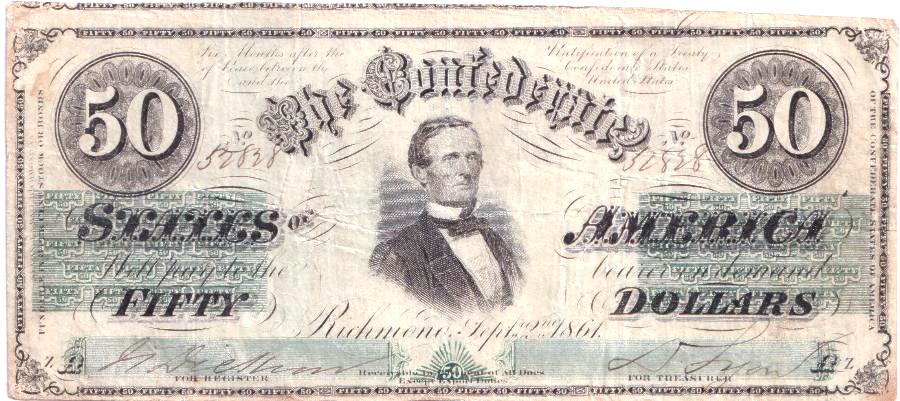
This is Bradbeer 80, Criswell Type 16 with the catalog number 80, and PF-1 subtype. This $50 note was issued on September 2, 1861 with a hand written serial number 32838. It features a portrait of Pres. Jefferson Davis. The note was hand signed by for Registrar J. T. Dickson and for Treasurer D. Lyon. The note was engraved by Keatinge & Ball, Richmond Va. There were 464,016 of these notes issued of which 103,000 were issued as the PF-1 subtype.
This is Bradbeer 106, Criswell Type 18 with the catalog number 107, and PF-7 subtype from Master Stone #1 (no flourishes between CONFEDERATE and STATES. This Plate K A $20 note was issued on September 2, 1861 with a hand written serial number 17006. It pictures a sailing ship with a vignette of a sailor leaning on a capstan at the lower left. The note was hand signed by for Registrar C. C. Thayer and for Treasurer Jno. Ott. The note was engraved by Hoyer & Ludwig, Richmond Va. There were 2,366,486 of these notes issued of which 39,200 were of this subtype.
This is Bradbeer 141, Criswell Type 20 with the catalog number 141, and PF-5 subtype. This First Series Plate 4 $20 note was issued on September 2, 1861 with a hand written serial number 67857. It pictures Industry flanked by Cupid and a beehive with a vignette of Vice President Alexander H. Stephens at the lower left and Hope with an anchor at the lower right. The note was hand signed by for Registrar J. T. Dickson and for Treasurer D. Lyon. The note was engraved by B. Duncan, Richmond. There were 2,834,251 of these notes issued of which 1,376.000 were of this subtype.
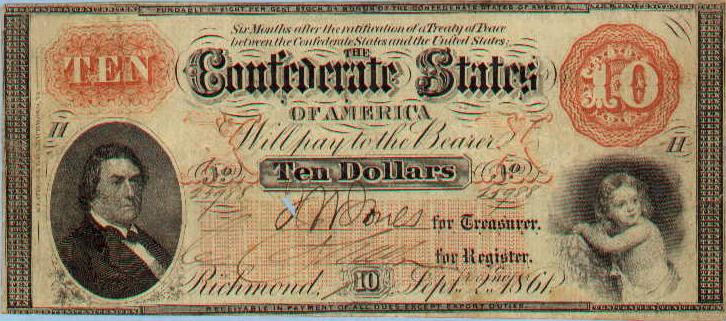
This is Bradbeer 156, Criswell Type 24 with the catalog number 156, and PF-1 subtype. This Plate H $10 note was issued on September 2, 1861 with a hand written serial number 25988. It has a vignette of Secretary of State R. M. T. Hunter at the lower left and a baby at the lower right. The note was hand signed by for Registrar C. C. Thayer and for Treasurer J. W. Jones. The note was engraved by Leggett, Keatinge & Ball, Richmond Va. There were 278,400 of these notes issued of which 58,400 were of this subtype.
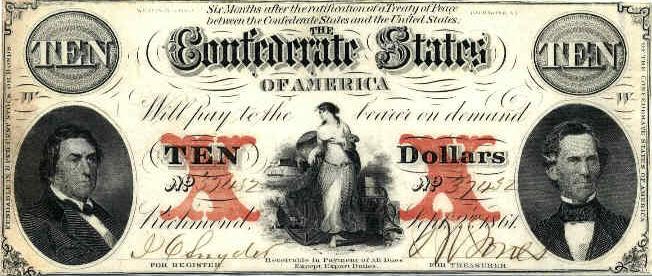
This is Bradbeer 173, Criswell Type 26 with the catalog number 173. This Plate W $10 note was issued on September 2, 1861 with a hand written serial number 37452. It has a central vignette of Hope with an anchor, Secretary of State R. M. T. Hunter at left and C. G. Memminger at right. The note was hand signed by for Registrar J. O. Snyder and for Treasurer J. W. Jones. This is the solid overprint X variety. The note was engraved by Keatinge & Ball, Richmond Va. There were 562,800 of these notes issued.
This is Bradbeer 232, Criswell Type 28 with the catalog number 232, and PF-3 subtype. This Plate A10 $10 note was issued on September 2, 1861 with a hand written serial number 35657. It has a vignette of Ceres with an urn (denoting Agriculture) and Commerce at the top left and a train at the right center. The note was hand signed by for Registrar M. C. Riggs and for Treasurer M. M. Young. The note was engraved by Hoyer & Ludwig, Richmond Va. There were 1,076,738 of these notes issued (some by Ludwig and others by J. T. Patterson) with 52,600 of this subtype.
This is Bradbeer 239, Criswell Type 30 with the catalog number 239 and PF-3 subtype. This Second Series Plate 4 $10 note was issued on September 2, 1861 with a hand written serial number 39561. It has a vignette of Gen Marion's Sweet Potato Dinner at center, Secretary of State R. M. T. Hunter at the lower left and Minerva at the right. The note was hand signed by for Registrar S. G. Tinsley and for Treasurer M.. Darby. The note was engraved by B. Duncan. There were 1,939,810 of these notes issued of which 978,939 were of this subtype.
This is Bradbeer 254, Criswell Type 33 with the catalog number 254a, and PF-2 subtype. This Plate O $5 note was issued on September 2, 1861 with a hand written serial number 25352. It has a vignette of Secretary of the Treasury C. G. Memminger at center, and Minerva at the right. The note was hand signed by for Registrar T. L. Crouch and for Treasurer A. W. Gray. The note was engraved by Keating & Ball Richmond VA. There were 136,736 of these notes issued wiyth 7,200 of thisd subtype.
This is Bradbeer 274, Criswell Type 36 with the catalog number 274, and PF-2 subtype. This Plate 13A $5 note was issued on September 2, 1861 with a hand written serial number 135491. It has a vignette of Commerce seated on a bale of cotton at center and a sailor leaning on a capstan at the lower left. The note was hand signed by for Registrar J. H. Harris and for Treasurer R. Bain. The note was engraved by J. Paterson, Columbia S.C. There were 3,694,890 of these notes issued with 880,000 of this subtype.
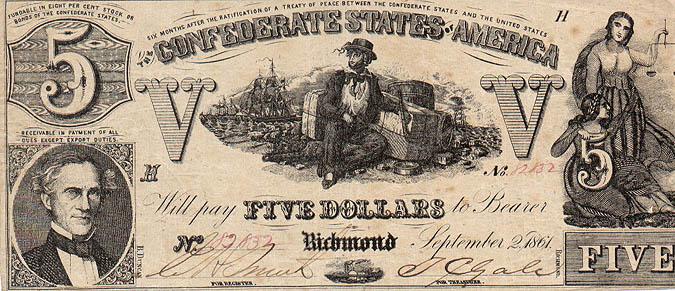
This is Bradbeer 284, Criswell Type 37 with the catalog number 284, and PF-1 subtype. This First Series Plate H $5 note was issued on September 2, 1861 with a hand written serial number 83832. It has a vignette of sailor seated with bales of cotton at center, Secretary of the Treasury Christopher Memminger at the lower left, Justice and Ceres at the right. The note was hand signed by for Registrar E. H. Smith and for Treasurer G. J. Gale. This series note was engraved by B. Duncan, Richmond. There were 1,002,478 of these notes issued 664,620 of this subtype.
This is Bradbeer 285, Criswell Type 37 with the catalog number 285, and PF-2 subtype. This Second Series Plate 3 $5 note was issued on September 2, 1861 with a hand written serial number 2871?. It has a vignette of sailor seated with bales of cotton at center, Secretary of the Treasury Christopher Memminger at the lower left, Justice and Ceres at the right. The note was hand signed by for Registrar (indistinct but J. P. Swords) and for Treasurer J. S. Lewis. The second series note was engraved by B. Duncan, Columbia SC. There were 1,002,478 of these notes issued 338,669 of this subtype.
This is Bradbeer 291, Criswell Type 39 with the catalog number 291,and PF-9 subtype. This Plate Ag 6 $100 interest bearing note was issued on June 20, 1862 with a hand written date and serial number 14991. It has a vignette of a train with straight steam with a ship in the distance at center and a milkmaid at the lower left. The note was hand signed by for Registrar R. J. Delony and for Treasurer H. Kepler. The note was engraved by J. T. Paterson, Columbia SC. There were 284,000 of these notes issued with 33,600 of this subtype. The back has handstamps: Interest Paid to 1st January 1863 Richmond; Interest Paid to 1st January 1863 Richmond; Interest Paid to 1st January 1864 Jackson and Interest Paid to 1st January 1865 Jackson. .
This is Bradbeer 300, Criswell Type 40 with the catalog number 300, and PF-5 subtype. This $100 Series Af interest bearing note was issued on October 25, 1862 with a hand written date of Augst 24, 1862 and serial number 38348. It has a vignette of a train with diffused steam with a ship in the distance at center and a milkmaid at the lower left. The note was hand signed by for Registrar J. M. Kinney and for Treasurer H. C. Williams. The note was engraved by J. T. Paterson, Columbia SC. There were 214,400 of these notes issued. The back has hand written statement "Issued Jackson Oct. 25 1862" and handstamps: Interest Paid to 1st January 1863 at Jackson; Interest Paid to 1st January 1864 at Jackson.
This is Bradbeer 316,Criswell Type 41 with the catalog number 316, and PF-15 subtype. This $100 Series Y Plate 2 interest bearing note was issued on November 6, 1862 with a hand written date and serial number 45163. It has Negro slaves hoeing a field at center, John C. Calhoun, renowned Southron senator at the lower left, and Columbia at right. The note as hand signed by for Registrar W. T. Snead and for Treasurer A. S. Watts. The note was engraved by Keatinge & Ball, Columbia SC. There were 678,600 of these notes issued with 27,500 of this subtype. This is Scroll 2 variety. The back has handstamps: Interest Paid to 1st January 1863 Savannah; Interest Paid to 1st January 1864 Augusta (very weak).
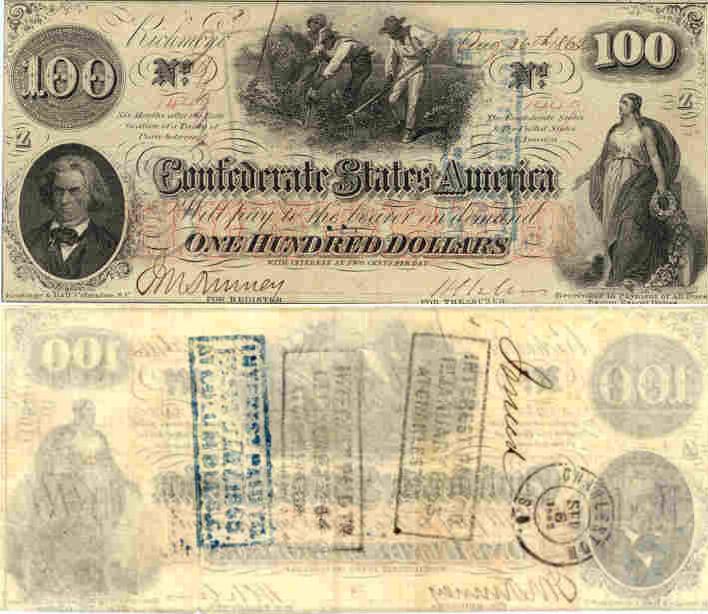
This is Bradbeer 316, Criswell Type 41 with the catalog number 316 and PF- subtype. This $100 Series Z interest bearing note was issued on October 29, 1862 with a hand written date and serial number 7400. It has Negro slaves hoeing a field at center, John C. Calhoun, renowned Southron senator at the lower left, and Columbia at right. The note was hand signed by for Registrar J. M. Kinney and for Treasurer H. C. Williams. The note was engraved by Keatinge & Ball, Columbia SC. There were 670,400 of these notes issued. The back has hand stamps: Issued Sep 8 1862 Charleston (postmark); Interest Paid to 1st January 1863 Charleston; Interest Paid to 1st January 1864 Charleston; blue Interest Paid to 1st January 1865 Columbia S.C. This is the Scroll 2 unwatermarked paper variety.
This is Bradbeer 318, Criswell Type 41 with the catalog number 318A, and PF- subtype. This $100 Plate X interest bearing note was issued on October 29, 1862 with a hand written date and serial number 33211. It has Negro slaves hoeing a field at center, John C. Calhoun, renowned Southron senator at the lower left, and Columbia at right. The note was hand signed by for Registrar W. T. Snead and for Treasurer A. S. Watts. The note was engraved by Keatinge & Ball, Columbia SC. There were 670,400 of these notes issued. The back has handstamps: Interest Paid to 1st January 1863 Savannah; Interest Paid to 1st January 1864 Tallahassee; Interest Paid to 1st January 1865 Tallahassee. This is the Scroll 2 variety engraved on block lettered C S A watermarked paper (the C and part of the S is visible from the back at about mid-center to top-center).
This is Bradbeer 336, Criswell Type 42 with the catalog number 336, and PF-3 subtype. This Second Series $2 note with plate number 3 was issued on June 2, 1862 with a hand written serial number 36359. It has a personification of the South striking down Northern tyranny at center and Judah P. Benjamin, Secretary of Treasury, at the upper left. The note was hand signed by for Registrar J. L. Johnston and for Treasurer E. H. Fauntleroy. The note was engraved by B. Duncan, Columbia SC. There were 1,520,000 of these notes issued with 432,500 oif this subtype.
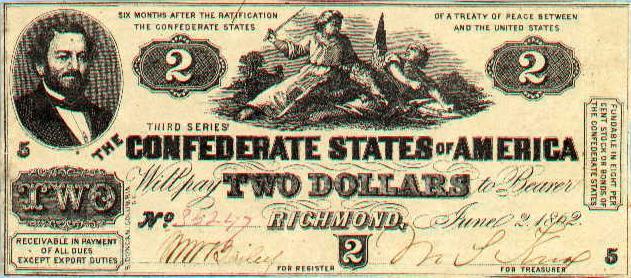
This is Bradbeer 337, Criswell Type 42 with the catalog number 337, and PF-5 subtype. This Third Series Plate 5 $2 note was issued on June 2, 1862 with a hand written serial number 35247. It has a personification of the South striking down Northern tyranny at center and Judah P. Benjamin, Secretary of Treasury, at the upper left. The note was hand signed by for Registrar M. H. Bailey and for Treasurer M. W. Knox. The note was engraved by B. Duncan, Columbia SC. There were 1,520,000 of these notes issued with 651,600 of this subtype.
This is Bradbeer 341, Criswell Type 44 with the catalog number 341,and PF-3 subtype. This Third Series Plate 8 $1 note was issued on June 2, 1862 with a hand written serial number 62698. It has a steamship at sea at center, Liberty at left, and Lucy Holcombe Pickens, wife of the South Carolina Governor, at lower right. The note was hand signed by for Registrar E. A. Adams and for Treasurer M. Godwin. The note was engraved by B. Duncan, Columbia SC. There were 1,689,860 of these notes issued with 870,000 of this subtype.
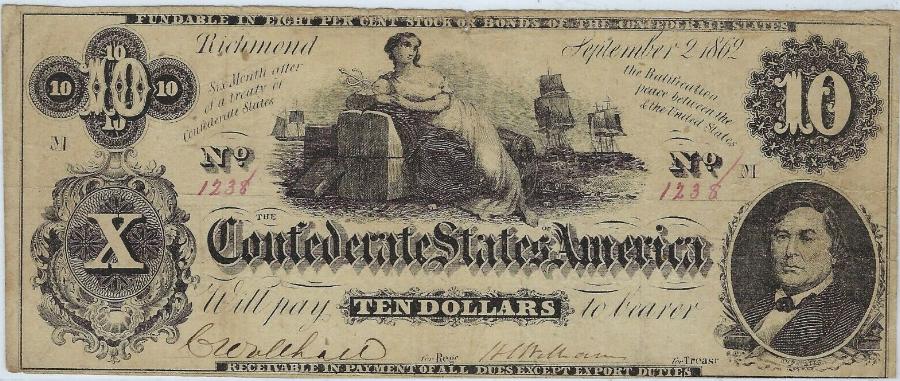
This is Bradbeer 343, Criswell Type 46 with the catalog number 344, and PF-1 subtype. This Plate M $10 note was issued on September 2, 1862 with a hand written serial number 1238. It has a Ceres resting on cotton bales with ships at center and R. M. T. Hunter at lower right. The note was hand signed by for Registrar C. Walthall and for Treasurer H. C. Williams. The note was printed by Hoyer & Ludwig . There were 635,250 of these notes issued with 264,000 of this subtype.
This is Bradbeer 369, Criswell Type 52 with the catalog number 369, and PF-1 subtype. This First Series H Plate $10 note was issued on December 2, 1862 with a hand written serial number 115135. It has The South Carolina State Capitol in Columbia at center and Senator R. M. T. Hunter, at lower right. The note was hand signed by for Registrar W. P. Caldwell and for Treasurer F. C. Weisiger. The note was engraved by Keatinge & Ball, , Columbia SC and printed by B. Duncan. There were 3,060,000 of these notes issued with 1,016,00 of this subtype.
This is Bradbeer 402, Criswell Type 56 with the catalog number 402.9, and PF-3 subtype. This Plate A $100 note was issued on 6th April 1863 with a red stamped serial number 33481, a red stamp DECEMBER 1863 vertically at right, and part of Treasury red seal at top right.. It has Lucy Holcombe Pickens (Bradbeer sais Mrs. center, two soldiers at lower left, and George W. Randolph, Secretary of War and Thomas Jefferson's youngest grandson, at lower right. The note was hand signed by for Registrar H. Smith and for Treasurer T. J. Hatch. The note was engraJefferson Davis) ved by Keatinge & Ball, Columbia SC. There were 1,950,400 of these notes issued with 894,400 of this subtype.
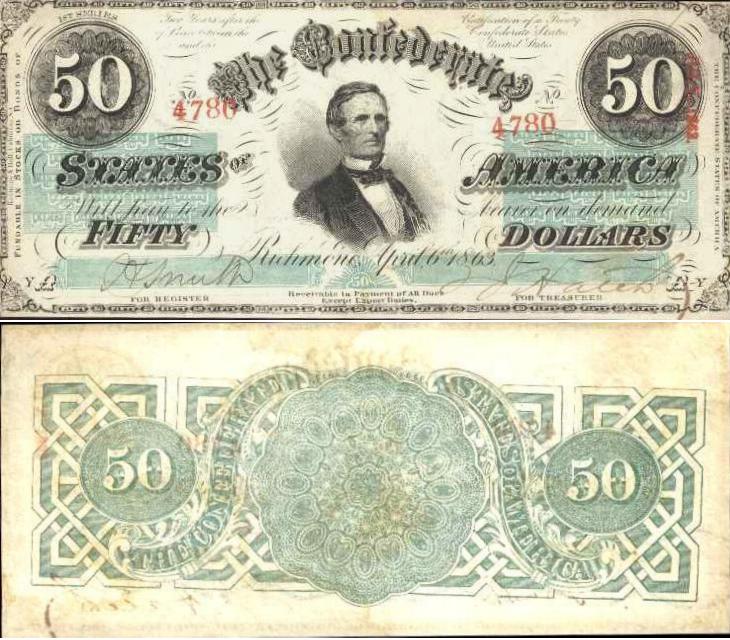
This is Bradbeer 409, Criswell Type 57 with the catalog number 409.1, and PF- subtype. This 1st Series Plate yA $50 note was issued on 6th April 1863 with a red stamped serial number 4780 and a red stamp MAY 1863 vertically at right. It has President Jefferson Davis at center. The note was hand signed by for Registrar H. Smith and for Treasurer T. J. Hatch. The note was engraved by Keatinge & Ball, Columbia SC. There were 2,349,600 of these notes issued.
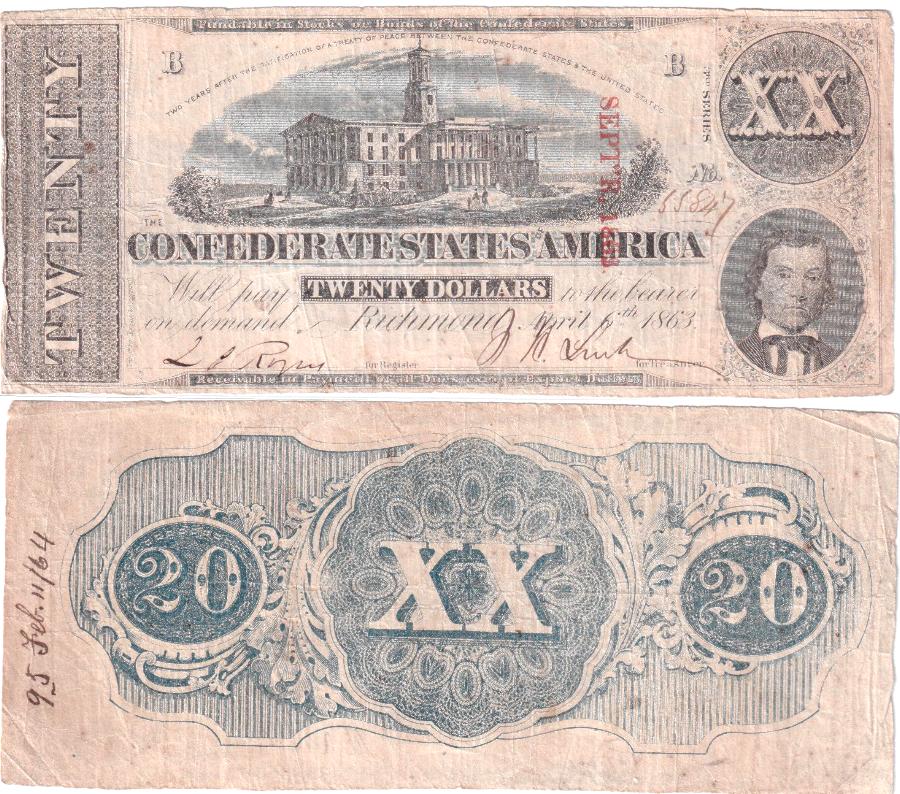
This is Bradbeer 427, Criswell Type 58 with the catalog number 427.9, and PF-28 subtype. This 3rd Series Plate B $20 note was issued on 6th April 1863 with a written serial number 55847 and a red stamp SEPT'R 1863 vertically at right. It has The State Capitol of Nashville, Tennessee in center and Vice President Alexander Stephens at right. The note was hand signed by for Registrar L. p. Rogers and for Treasurer F. H. Link. The note was lithographed by Evans & Cogswell and ]engraved by Keatinge & Ball, Columbia, SC. There were 4,429,600 of these notes issued of which 232,000 were of this subtype.

This is Bradbeer 443, Criswell Type 59 with the catalog number 443.7, and PF-26 subtype. This 1st Series Plate G $10 note was issued on 6th April 1863 with a wriotten serial number 88488 and a red stamp JULY, 1863 vertically at right. It has State Capitol of Columbia, South Carolina, at center. and R.M.T. Hunter at right. The note was hand signed by for Registrar M. S. Apperson and for Treasurer M. B. Christian. The note was lithographed by Evans & Cogswell. There were 7.420,800 of these notes issued with 439,450 of this subtype.
issued.
This is Bradbeer 453, Criswell Type 60 with the catalog number 453.6, and PF-11 subtype. This E Plate 2nd Series $5 note was issued on April 6th 1863 with a hand written serial number 33635 and a red stamp JUNE 1863 vertically at right. It has Capitol of the Confederate States in Richmond at center and Christopher Memminger at lower right. The note was hand signed by for Registrar M. Morrison and for Treasurer H. Starke. The note was engraved by Keatinge & Ball, Columbia S.C. and lithographed by J. T. Paterson & Co. There were 7,745,600 of these notes issued of which 682,100 of this subtype.
This is Bradbeer 471, Criswell Type 61 with the catalog number 471, and PF6 subtype. This G. Plate 2nd Series $2 note was issued on April 6th 1863 with a hand written serial number 37469. It has a portrait of Judah P. Benjamin at right. The note was hand signed by for Registrar by K. Walker and for Treasurer A. B. Capron. The note was engraved by Keatinge & Ball, Columbia S.C.There were 689,200 of these notes issued of which 337,600 of this subtype.
This is Bradbeer 474, Criswell Type 62 with the catalog number 474, and PF-1 subtype. This is Plate F 1st Series $1 note was issued on April 6th 1863 with a hand written serial number 11419. It has Alabama Senator Clement C. Clay at center. The note was hand signed by for Registrar M. Morrison and for Treasurer H. Starke. The note was engraved by Keatinge & Ball, Columbia SC. There were 1,645,000 of these notes issued of which 1,035,000 of this subtype.
This is Bradbeer 488, Criswell Type 63 with the catalog number 488, and PF-6 subtype. This Plate D 50 cents note was issued on April 6th 1863 with a stamped serial number 27573. It has President Jefferson Davis at center. The note printed signatures Ro. Tyler and E. C. Elmore. The note was engraved by Archer & Daly, Richmond, Va. There were 1,831,517 notes issued of which about 100,000 were of this subtype.
issued.
This is Bradbeer 489, Criswell Type 64 with the catalog number 489, and PF-1 subtype. This Plate C $500 note was issued on February 17th 1864 with a stamped serial number 23879. It has Battle Flag abnd the Great Seal at left with Gen. T. J. "Stonewall" Jackson at lower right The note was hand signed by for Registrar L. W. Elliott and for Treasurer R. Haynes. The note was engraved by Keatinge & Ball, Columbia SC and was issued uniface. There were 156,000 notes issued.
This is Bradbeer 494, Criswell Type 65 with the catalog number 494, and PF-3 subtype. This Plate D Series II Series 1 $100 note was issued on February 17th 1864 with a stamped serial number 5307. It has Lucy Holcombe Pickens center, two soldiers at lower left, and George W. Randolph, Secretary of War and Thomas Jefferson's youngest grandson, at lower right. The note was hand signed by for Registrar S. Johnson and for Treasurer A. Harrison. The note was engraved by Keatinge & Ball, Columbia SC. There were 929,200 notes issued.
This is Bradbeer 498, Criswell Type 66 with the catalog number 498, and PF-6 subtype. This Plate YA 3 Series $50 note was issued on February 17th 1864 with a stamped serial number 3752. It has President Jefferson Davis at center. The note was hand signed by for Registrar M. A. Yates and for Treasurer M. Wade. The note was engraved by Keatinge & Ball, Columbia SC. There were 1,671,444 notes issued.
This is Bradbeer 514, Criswell Type 67 with the catalog number 514, and PF-14 subtype. This X Series Plate D $20 note was issued on February 17th 1864 with a hand written serial number 12734. It has the Tennessee State Capitol in Nashville at center and Vice President Alexander H. Stephens at lower right. The note was hand signed by for Registrar (illegible) and for Treasurer J. Ambler. The note was engraved by Keatinge & Ball, Columbia SC. There were 4,297,004 notes issued.
This is Bradbeer 541, Criswell Type 68 with the catalog number 541, and PF-3 subtype. This 1 Series Plate H Number 63 $10 note was issued on February 17th 1864 with a hand written serial number 49501. It has horses pulling a cannon and R. M. T. Hunter at lower right. The note was hand signed by for Registrar C. Percival and for Treasurer S McCants. The note was engraved by Keatinge & Ball, Columbia SC and printed by Evans & Cogswell. There were 9.145,000 notes issued with 425,800 of this subtype.
This is Bradbeer 552, Criswell Type 68 with the catalog number 552, and PF-44 subtype. This 10 Series Plate E Number 50 $10 note was issued on February 17th 1864 with a hand written serial number 43277. It has horses pulling a cannon and R. M. T. Hunter at lower right. The note was hand signed by for Registrar E. G. Winston and for Treasurer S. McCants. The note was engraved by Keatinge & Ball Columbia SC and lithographed by Evans & Cogswell. There were 9.145,000 notes issued with 560.000 of this subtype.
This is Bradbeer 558, Criswell Type 69 with the catalog number 558, and PF-1 subtype. This D Plate Number 12 $5 note was issued on February 17th 1864 with a hand written serial number 53084. It has Capitol of the Confederate States in Richmond at center and Christopher Memminger at lower right. The note was hand signed for Registrar by S. C. Hayes and for Treasurer by E. S. Read. The note was lithographed by J. T. Paterson, Columbia SC. There were 5,527,.200 notes issued with 425,800 of this subtype.
This is Bradbeer 560, Criswell Type 69 with the catalog number 560, and PF-5 subtype. This Series 2 Plate H Number 54 $5 note was issued on February 17th 1864 with a hand written serial number 37046. It has Capitol of the Confederate States in Richmond at center and Christopher Memminger at lower right. The note was hand signed by for Registrar B. Dabney and for Treasurer M. Selden. The note was engraved by Keatinge & Ball Columbia SC and lithographed by Evans & Cogswell. There were 5,527,500 notes issued with 779,20000 of this subtype.
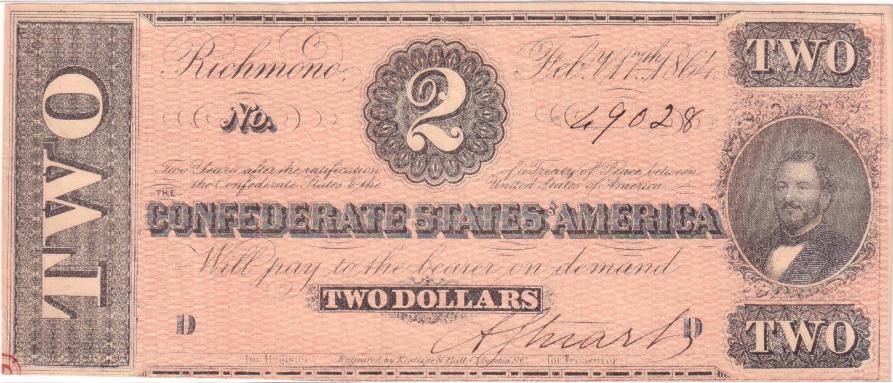
This is Bradbeer 566, Criswell Type 70 with the catalog number
566, and PF-4 subtype. This Plate D $2 note was issued on February 17th 1864 with a
written serial number 49028. It has Judah P. Benjamin at right. The note was
engraved by Keatinge & Ball, Columbia, S.C.. The note was hand signed by
for Registrar (Blank unsigned) and for Treasurer A. Stuart. There were 932,800 notes issued
of which 80,000 were of this variety.

This is Bradbeer 574, Criswell Type 71 with the catalog number 574, and PF-12 subtype. This .H Plate $1 note was issued on February 17th 1864 with a written serial number 71250. It has Sen. Clement C. Clay at center. The note was hand signed by for Registrar (Blank unsigned) and for Treasurer A. Camson. The note was engraved by Keatinge & Ball There were 945,600 notes issued of which 478,600 were of this variety.
This is Bradbeer 578, Criswell Type 72 with the catalog number 578, and PF-1 subtype. This 50 cents note was issued on February 17th 1864 with a stamped serial number 64526. It has President Jefferson Davis at center. The note printed signatures Ro. Tyler and E. C. Elmore. The note was engraved by Archer & Halpin, Richmond, Va. There were 1,132,000 notes issued.
State Government Currency
Most of the State governments in the CSA issued currency during the War. Presented here are examples from most of these States. The standard listing for these is Grover Criswell's Confederate and Southern States Currency.
Most States and many cities and counties throughout the Soutrh issuued currency for local use. Many of these were printed on the backs of other financial paper due to the severe shortage of paper in the South. Many local banks also issued emergency currency.
One post war note of great interest to Southron collectors is this one:
This note of the Marion, Selma and Memphis Railroad Company was issued in 1871 and signed by N. B. Forrest. During the war General Nathan Bedford Forrest was the scourge of Yankeedom. He enlisted as a private and advanced to Lieut. General. He operated pretty independently and bravely and was called the "Wizard of the Saddle." When the war started, Forrest asked 45 of his slaves (which he considered as servants) to join him, offering them their freedom after the war, no matter how it turned out. They all joined him and although they had numerous opportunities to desert him, 44 stayed by his side until the end of the war. In fact, part of his special command escort later called "the green berets", consisted of the most elite and best soldiers available, and among them were eight black men. Are you you are aware that nearly 100,000 black men fought for the Confederacy and many of these received State pensions for their service? You probably didn't because of the modern history that blackens the names of every Southern hero of the War.
In my opinion, he was the best general officer on either side.
ALABAMA
Alabama passed a Secession Ordinance on January 11, 1861 on a vote of 61 for and 29 against. It was the fourth State to secede. The seceding States met in Montgomery at the State Capitol to form the Confederate States of America on February 4, 1861
Alabama first issued State currency on January 1, 1863.The first notes bore the printed signature of the Governor, John Gill Shorter. All the notes were engraved and printed by J. T. Paterson of Augusta, Georgia.
This is Criswell AL-3. The vignette at the center is of a wagonload of cotton. The image of the State's seal is at upper left and Juliet Hopkins', the Florence Nightingale of the South, portrait is at lower right. The note bears hand written serial number 79220 and was printed from Plate K.
This is Criswell AL-4. The vignette at the center is of State seal. The image of Juliet Hopkins', the Florence Nightingale of the South, portrait is at lower right. The note bears hand written serial number 70163 and was printed from Plate D.
This is Criswell AL-1. The vignette at the center is of State Capitol. The image of Governor John Gill Shorter is at left. The note bears hand written serial number 70163 and hand signed by D. M. Hill, It was printed from Plate G
ARKANSAS
Arkansas seceded from the Union on May 6, 1861, becoming the 6th State to secede by a vote of 59 for and 1 against.
This is Criswell AR-33IAB. This is a Treasury Warrant on War Bond for $1 issued on the hand written date of August 21, 1863. It was signed by L. B. Cunningham as Treasurer. bIt bears two hand written numbers, 102043 at left and 2482 at right. It was printed from Plate A on the back a sheet of Exchange Notes from a bank in Van Buren, Arkansas with a green overprint of ARKANSAS TREASURY WARRANT in flourishes. It was printed by J. D. Butler, Print Lit Rock.
FLORIDA
The Secession Ordinance was passed on January 10, 1861 by a vote of 62 for and 7 against.
, 10
This is Criswell FL-24. This is a banknote for 25 cents issued in Tallahassee on Feb'y 2nd 1863. It was signed by C. H. Austin as Treasurer and co-signed by A. Randolph, John Millen, and C. Drysdale.
GEORGIA
Georgia's Secession Ordinance was passed by a vote of 208 for and 89 against. Georgia issued notes in denominations of 5¢, 10¢, 15¢, 20¢, 25¢, 50¢, 75¢, $1, $2, $3, $4, $5, $10, $20, $50, $100, and $500. The following are issues of each denomination except for the extremely rare $500. The notes were issued under various acts of the Georgia Assembly and were dated 1862, 1863, and 1864. The catalog numbers reefer to Grover Criswell's works and the Martin/Latimer new system as used in their epic study State of Georgia - Treasury Notes, Treasury Certificates, & Bonds..
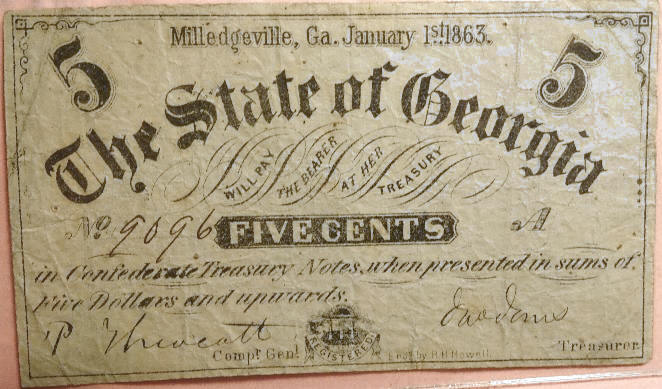
This is Criswell GA-19 / ML-20E. This is a Plate A banknote for 5 cents issued in Milledgeville on January 1st 1863. It bears printed signatures of Jno. Jones as Treasurer and P. Thweatt as Comptroller General. It has the hand written serial number 9096. It was engraved by R. Howell. There were 403,200 of these notes issued.
This is Criswell GA-18 / ML-7. This is a Plate B banknote for 10 cents issued in Milledgeville on January 1st 1863. It bears printed signatures of Jno. Jones as Treasurer and P. Thweatt as Comptroller General. It has the hand written serial number 15200. It was engraved by R. Howell. There were 464,000 of these notes issued.
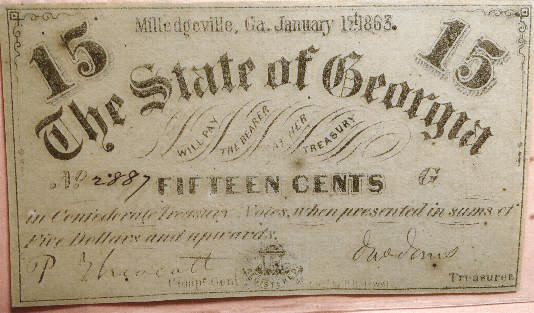
This is Criswell GA-17 / ML-8. This is a Plate G banknote for 15 cents issued in Milledgeville on January 1st 1863. It bears printed signatures of Jno. Jones as Treasurer and P. Thweatt as Comptroller General. It has the hand written serial number 2887. It was engraved by R. Howell. There were 66,600 of these notes issued.
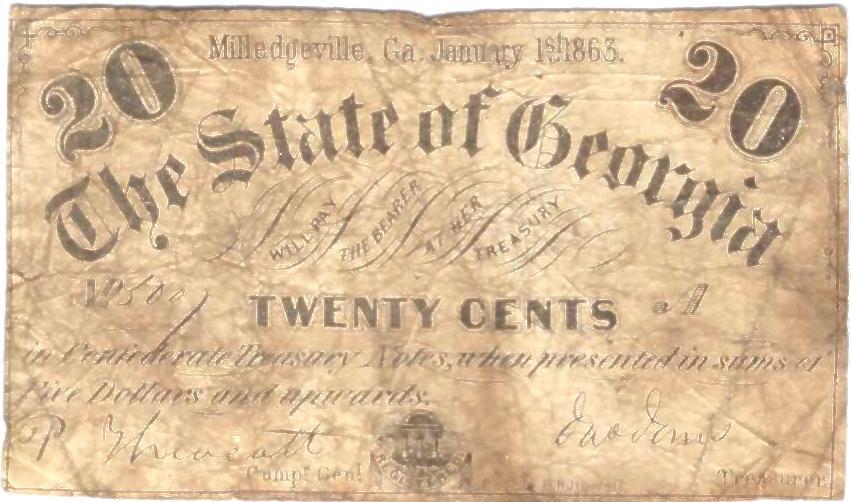
This is Criswell GA-16 / ML-9. This is a Plate A banknote for 20 cents issued in Milledgeville on January 1st 1863. It bears printed signatures of Jno. Jones as Treasurer and P. Thweatt as Comptroller General. It has the hand written serial number 5007. It was engraved by R. Howell. There were 12,600 of these notes issued.
This is Criswell GA-15 / ML-10. This is a Plate J banknote for 25 cents issued in Milledgeville on January 1st 1863. It bears hand written signatures of J. R. McCamy as Treasurer and J. C. Strickland as Comptroller General. It has the hand written serial number 77313. It was engraved by R. Howell. There were 898,900 of these notes issued.
This is Criswell GA-15A / ML-13A. This is a script Plate F banknote for 50 cents issued in Milledgeville on January 1st 1863. It has a vignette of a group of workmen and bears hand written signatures of R. M. Cartellaw for Treasurer and J. M. Beall for Comptroller General. It has the hand written serial number 34615. It has a green Treasury seal at top right. It was produced by Howell, Engraver. There were 29,700 of these notes issued.
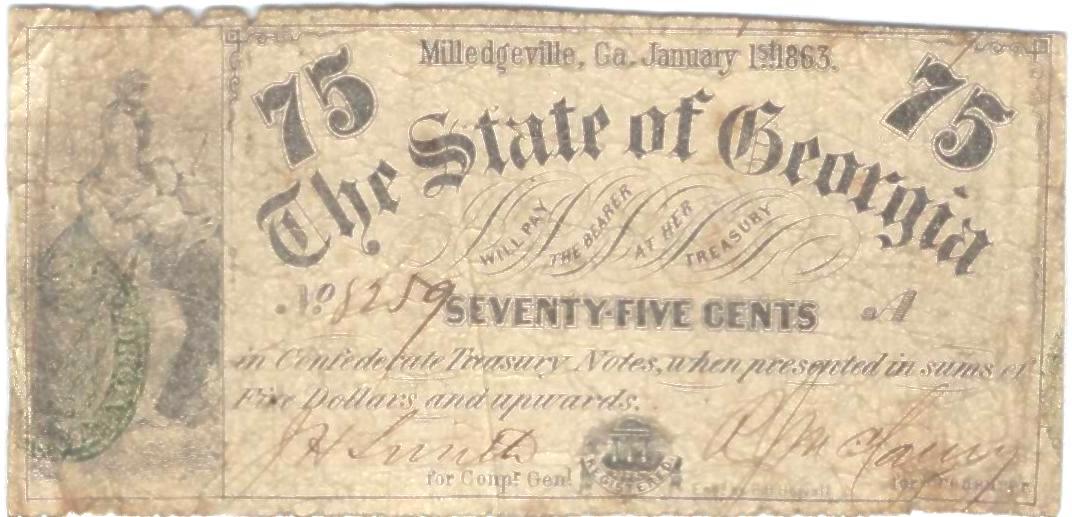
This is Criswell GA-134 / ML-14. This is a script Plate A banknote for 75 cents issued in Milledgeville on January 1st 1863. It has a vignette of a group of workmen and bears hand written signatures of J. R. McCamy for Treasurer and J. H. Smith for Comptroller General. It has the hand written serial number 8259. It has a green Treasury seal at top right. It was produced by Howell,Engraver. There were 10,000 of these notes issued.
This is Criswell GA-30 / ML-23B. This is a Plate A banknote for $1 issued in Milledgeville on January 1st 1864. It has a vignette of a train and bears hand written signatures of R. M. Cartellaw for Treasurer and J. M. Beall for Comptroller General. It has the hand written serial number 3461. It was produced by Howell, Engraver. There were 39,000 of these notes issued. This variety has the broken top border lines at left and right.
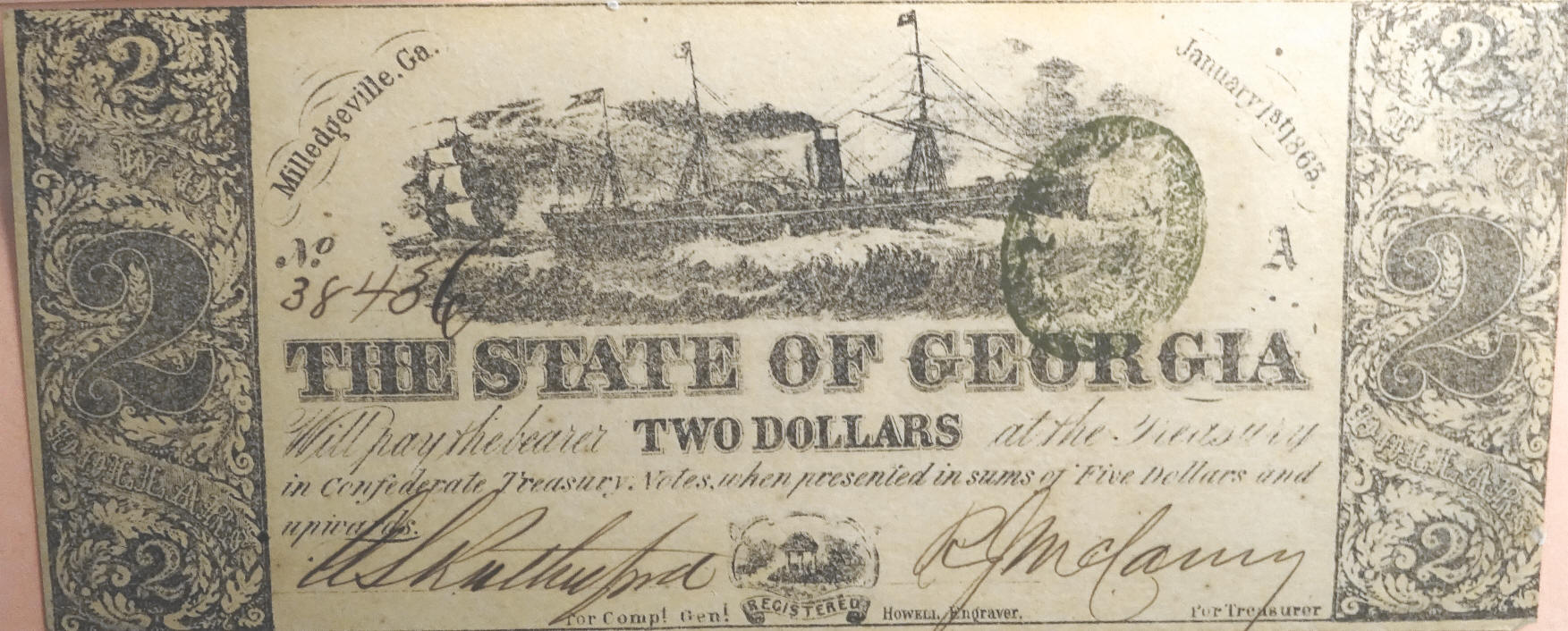
This is Criswell GA-11/ ML-16. This is a Plate A banknote for $2 issued in Milledgeville on January 1st 1863. It has a vignette of ships at sea and bears hand written signatures of R. J. McCamy for Treasurer and A. S. Rutherford for Comptroller General. It has the hand written serial number 38486. It was produced by Howell, Engraver. There were 50,000 of these notes issued.
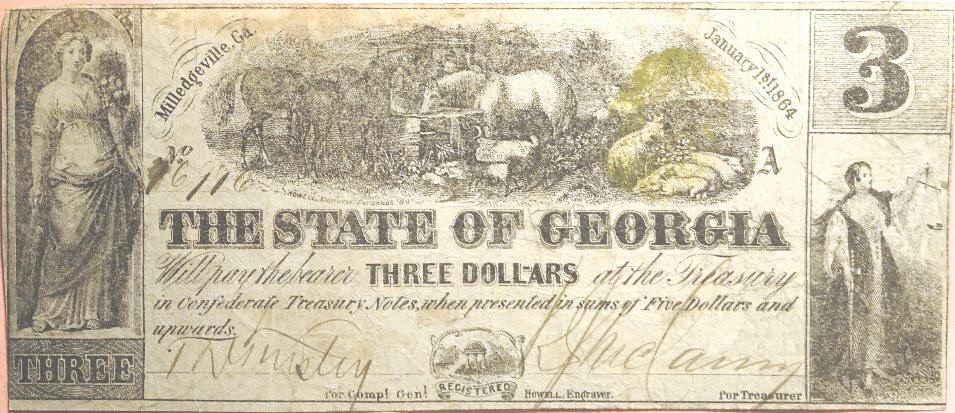
This is Criswell GA-28 / ML-25. This is a Plate A banknote for $3 issued in Milledgeville on January 1st 1864. It has a vignette of farm animals and bears hand written signatures of R. J. McCamy for Treasurer and T. D. Tinsley for Comptroller General. It has the hand written serial number 6976. It was produced by Howell, Engraver. There were 50,000 of these notes issued.
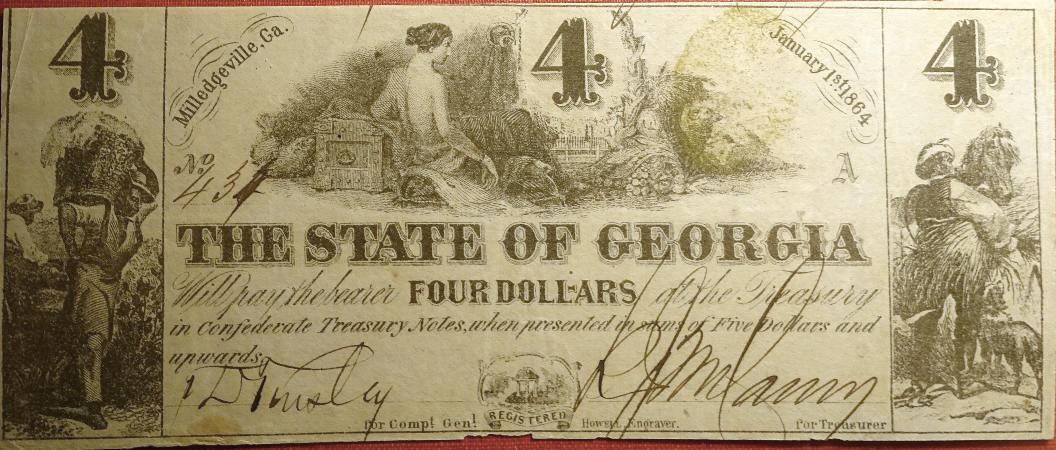
This is Criswell GA-27 / ML-26. This is a Plate A banknote for $4 issued in Milledgeville on January 1st 1866. It has a vignette of Moneta by a chest with a slave carrying cotton at left and a wheat harvester at right and bears hand written signatures of R. J. McCamy for Treasurer and T. D. Tinsley for Comptroller General. It has the hand written serial number 434. It was produced by Howell, Engraver. There were 25,000 of these notes issued.
This is Criswell GA-5/ ML-1B. This is a Plate A banknote for $5 issued in Milledgeville on January 15th 1862. It has a vignette of James Oglethorpe, founder of Georgia, in military uniform and bears hand written signatures of Jno. Jones as Treasurer and T. J. Bloodworth for Comptroller General. It has the hand written serial number 13922. It has the black Treasury seal on the back. The red overprint is too low. It was produced by Howell, Engr Savannah. There were 200,000 of these notes issued.
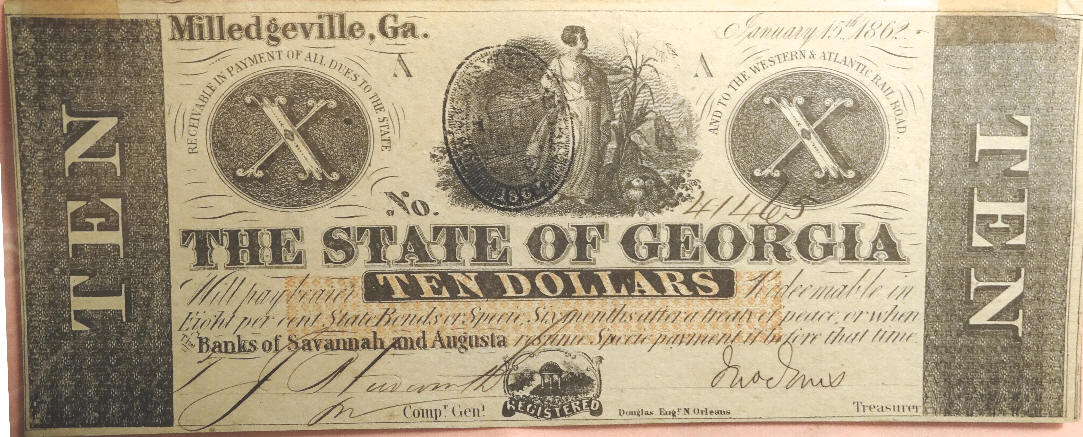
This is Criswell GA-4 / ML-2. This is a Plate A banknote for $10 issued in Milledgeville on January 15th 1862. It has a vignette of Ceres holding grain and bears hand written signatures of Jno. Jones as Treasurer and T. J. Bloodworth for Comptroller General. It has the hand written serial number 41465. It has the Treasury seal on the back. It was produced by Howell, Engr Savannah. There were 54,000 of these notes issued.
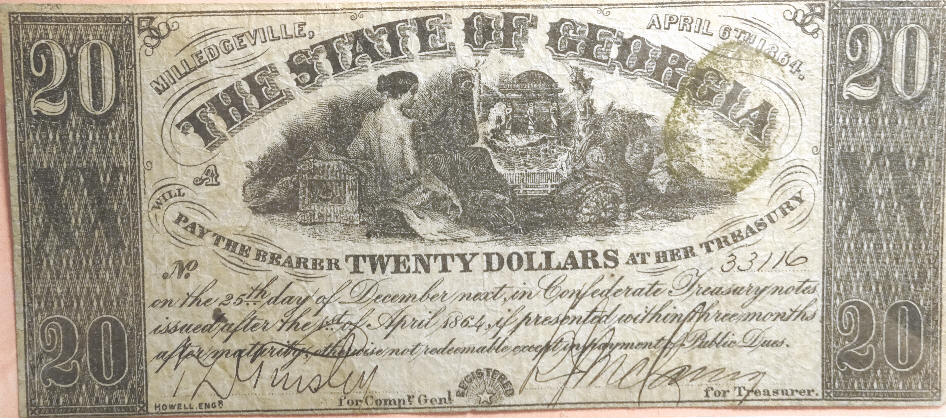
This is Criswell GA-28 / ML-25. This is a Plate A banknote for $20 issued in Milledgeville on April 6th 1864. It has a vignette of Ceres holding grain and bears hand written signatures of R. J. McCamy as Treasurer and T. D. Tinsley for Comptroller General. It has the hand written serial number 33116. It has the Treasury seal on the back. It was produced by Howell, Engr Savannah. There were 75,000 of these notes issued.
This is Criswell GA-7 / ML-20. This is a Plate A banknote for $50 issued in Milledgeville on February 2nd 1863. It has a vignette of the Georgia State Seal at center left and bears hand written signatures of Jno. Jones as Treasurer and T. J. Bloodworth for Comptroller General. It has the hand written serial number 10688.It has the black Treasury seal on the back. It was produced by Howell, Savannah. There were 30,000 of these notes issued.
This is Criswell GA-6 / ML-21. This is a Plate A banknote for $100 issued in Milledgeville on February 1st 1863. It has a vignette of Governor Joseph E. Brown at center left and bears hand written signatures of Jno. Jones as Treasurer and T. J. Bloodworth for Comptroller General. It has the hand written serial number 26605.It has the black Treasury seal on the back. It was produced by Howell, Savannah. There were 30,000 of these notes issued.
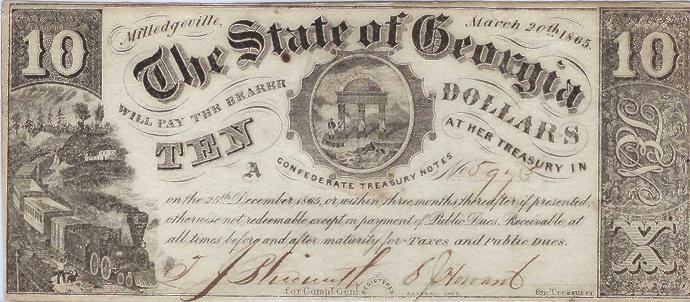
This is Criswell GA-33 / ML-39. This is a Plate A banknote for $10 issued in Milledgeville on March 20th 1865. It has a vignette of a railroad train at center left and the state arms at center. it bears hand written signatures of S. J. Howard as Treasurer and T. J. Bloodworth for Comptroller General. It has the hand written serial number 5973. It has the black Treasury seal on the back. It was produced by R. H. Howell, Eng'r. There were 7,000 of these notes issued. This was the last note payable in Confederate currency issued barely three weeks before Gen. Lee surrendered at Appomattox Court House, Virginia.
LOUISIANA
Louisiana passed its Ordinance of Secession on January 26, 1861 by a vote of 113 to 17. Louisiana raised about 1,000 military companies for the CSA including several Negro regiments.
This is Criswell LA-8. This is a Plate B banknote for $1 issued in Baton Rouge on February 24th 1862. It has the State Seal of a beehive center bottom and bears hand written signatures of B. L. Depree for Treasurer and C. H. Peralta for Auditor. It has the hand written serial number 1581. It was produced by Douglas, N. Orleans and was printed on the back of a sheet of $5 notes printed for a New Orleans bank.
This is Criswell LA-4. This is a Plate A banknote for $1 issued in Baton Rouge on February 24th 1862. It has the State Seal of a beehive center bottom and bears hand written signatures of B. L. Depree for Treasurer and C. H. Peralta for Auditor. It has the hand written serial number 1581. It was produced by Douglas, N. Orleans and was printed on the back of a sheet of $20 notes printed for the Exchange Bank of Holly Springs, Mississippi.
This is Criswell LA-10. This is a Plate E banknote for $5 issued in Baton Rouge on October 10th 1862. It has vignette of the South striking down Northern tyranny and bears hand written signatures of B. L. Depree for Treasurer and C. H. Peralta for Auditor. It has the hand written serial number 33070. The reverse is printed in green. It was produced by B. Duncan, Columbia.
This is Criswell LA-14. This is a Plate E banknote for $5 issued in Shreveport on March 10th 1863. It has vignette of the South striking down Northern tyranny and bears hand written signatures of J. R. Hyams for Treasurer and L. Peralta for Auditor. It has the hand written serial number 419. The reverse is printed in green. It was produced by B. Duncan, Columb.
MISSISSIPPI
Mississippi passed its Secession Ordinance on January 9 1861 by a vote of 83 to 15.
This is Criswell MS-43. This is a Plate B banknote for $2 issued in Macon on May 1st 1863. It has the vignette of a sailing vessel at center and a sailor leaning on a capstan at left and bears the hand written signature of A. J. Gillespie for Auditor. It has the hand written serial number 27488.
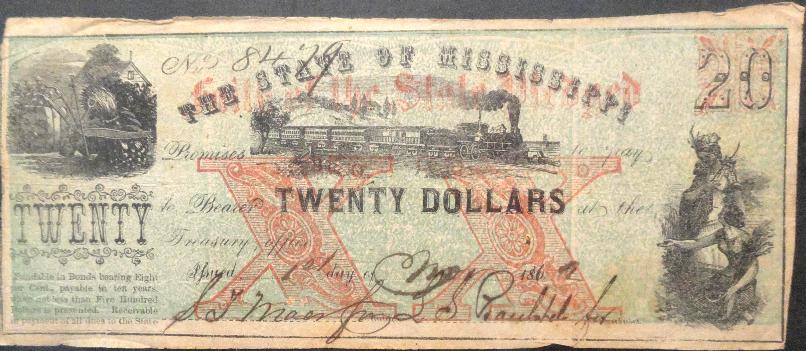
This is Criswell MS-34. This is a banknote for $20 issued on May 1st1st Nov 1862. It has vignette of a train at center, a plow and rural scene at left top, and two women at the lower right. It bears the hand written signatures of S. T. Manfred and L. S. Paychtel. It has the hand written serial number 84708.
This is Criswell MS-49. This is a Plate F banknote for $50 issued in Macon on May 1st 1863. It has the vignette of a sailing vessel at center and a sailor leaning on a capstan at left and bears the hand written signatures of T. T. Swann for Auditor and A. Rmigher for Treasurer. It has the hand written serial number 179. It has an ornate back printed in orange. It was produced by J. T. Paterson Lithographers Augusta Ga.
MISSOURI
Missouri overwhelmingly voted against Lincoln in the 1860 election. The Governor tried to get a Secession Ordinance through but was thwarted by the Legislature. They did pass a provision refusing to provide troops to the Federals. Missouri was admitted to the CSA on November 28, 1861.
This is Criswell MO-12. This is a banknote for $1 issued in Jefferson City on January 1st 1862. It has the vignette of President Jefferson Davis flanked by flags and instruments of war at center, a gladiator at left, and a hunter with dog at right. It bears the hand written signature of N. Shields as Cmr. It has the hand written serial number 61355. It was engraved by. A. Malus Eng N.O. and was printed on the back of a sheet of bank drafts drawn on the Union Bank of New Orleans.
This is Criswell MO-04A. This is a banknote for $10 issued in Jefferson City on January 1st 1862. It has the vignette of Ceres with cornucopia at center and a ship at left with an iron-clad at center bottom. It bears the hand written signature of Tho. H. Murray As Cmr and co-signed by C. J. Jackson. It has the hand written serial number 2406. The note was issued uniface but the back bears a stamp "Prior to 1st, Nov'br 1861."
This is Criswell MO-18B. This is an unissued requisition for defense bonds that circulated as currency $1 undated. It has a vignette of a rural scene at center, a belle at bottom right, and the State Seal at lower left. It was engraved by Keatinge & Ball Columbia SC.
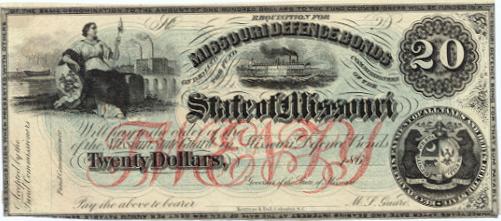
This is Criswell MO-21. This is an unissued requisition for defense bonds that circulated as currency $20 undated. It has a vignette of a steamship at center, Liberty seated at upper left, and the State Seal at lower right. It was engraved by Keatinge & Ball Columbia SC. This has a green ornate reverse like the $100 below but I did not scan it at the time.
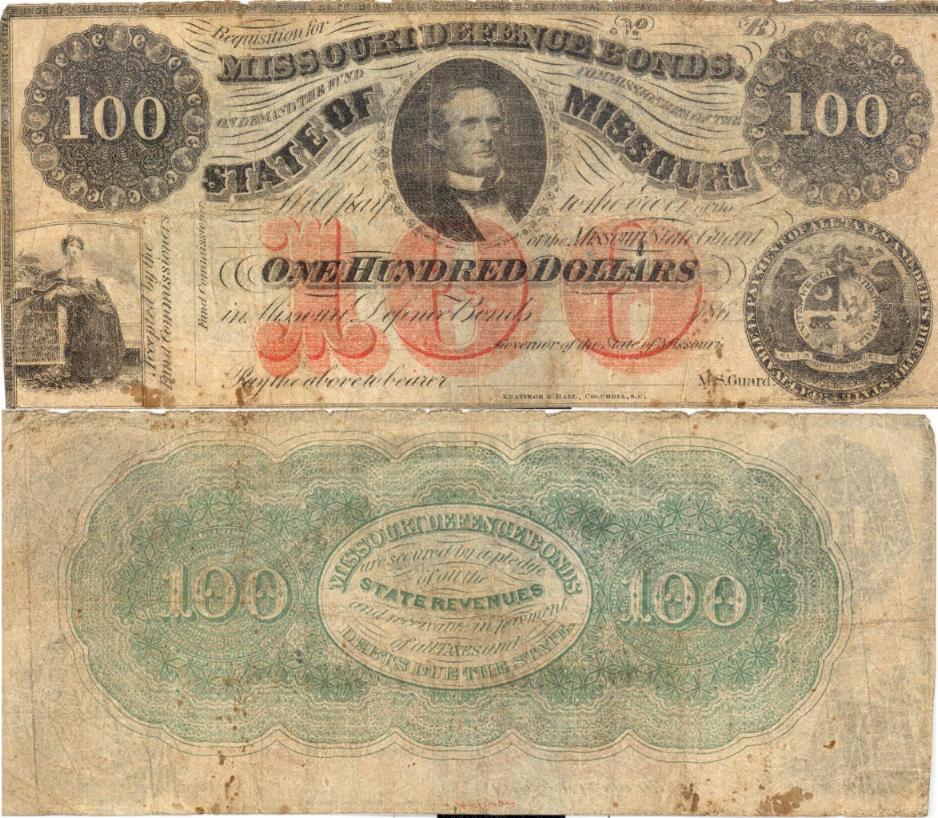
This is Criswell MO-19. This is an unissued requisition for defense bonds that circulated as currency $100 undated. It has a vignette of President Jefferson Davis at center, a belle at upper left, and he State Seal at lower right. It was engraved by Keatinge & Ball Columbia SC.
NORTH CAROLINA
North Carolina unanimously approved a Secession Ordinance on May 20 1861.
This is Criswell NC-113. This is a Plate R banknote for 10 cents issued in Raleigh on Sept. 1st 1862. It has the vignette of a hornets' nest at center. It bears the hand written signature of R. G. Lindsey for Public Treasurer It has the hand written serial number 137. It was produced by. J. T. Paterson Augusta Ga.
This is Criswell NC-149. This is a Plate L banknote for 50 cents issued in Raleigh on Jany 2nd 1864. It has the vignette of a sailing vessel at center. It bears the hand written signature of W. H. Dodd for Public Treasurer It has the hand written serial number 186. It was produced by. J. T. Paterson Augusta Ga.
This is Criswell NC-22. This is a Plate A banknote for $2 issued in Raleigh on January 1st 1863. It has the vignette of the State Capitol at center. It bears the hand written signature of D. W.Bain for Public Treasurer It has the hand written serial number 97. It was produced by. J. T. Paterson Augusta Ga.
This is Criswell NC-21. This is a Plate A banknote for $2 issued in Raleigh on Oct. 2nd 1861. It bears the hand written signature of (indistinct) for Public Treasurer It has the hand written serial number 2304. It was produced by F. W. Bornemann Charleston SC.
This is Criswell NC-22. This is a Plate E banknote for $2 issued in Raleigh on Oct. 6th 1861. It bears the hand written signature of Henry Hardee for Public Treasurer It has the hand written serial number 710. It was produced by F. W. Bornemann Charleston SC.
This is Criswell NC-123. This is a Plate D banknote for $5 issued in Raleigh on 1st Jany 1863. It bears the hand written signature of W. T. Thimble for Comptroller and W. A. Jones for Public Treasurer It has the hand written serial number 236. It was engraved and lithographed by J. T. Paterson, Augusta Ga
SOUTH CAROLINA
South Carolina enacted its Ordinance of Secession on December 20 1861 by unanimous vote.
There are no State issues from South Carolina during the War. This is is a 25 cents voice issued by a private institution, the Bank of the State of South Carolina. It was issued on Feb. 1 1863.
TEXAS
Texas's Secession Ordinance was passed on February 1 1861 by a vote of 168 to 8. The Ordinance was submitted for popular vote which passed by 46,129 to 16,1`97.
This is Criswell TX-1. This is a Treasury Warrant for Military Service for $1 to J. P. Du..... or Bearer issued in Austin on July 29, 1862. It has a vignette of a milkmaid at left and it bears the hand written signature of C. R. Johns for Comptroller. It has the hand written serial number 91595.
This is Criswell TX-2. This is a Treasury Warrant for Civil Service for $1 to F. R. Lubbock or Bearer issued in Austin on July 7, 1862. It has a vignette of a milkmaid at left and it bears the hand written signature of C. R. Johns for Comptroller. It has the hand written serial number 2807. It was endorsed on the back by C. V. Randolph.
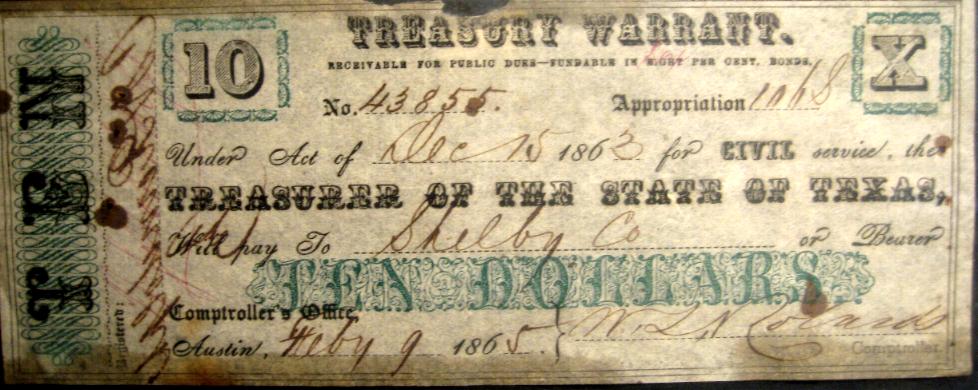
This is Criswell TX-20. This is a Treasury Warrant for Civil Service for $10 to Shelby Co, or Bearer issued in Austin on Feby 9 1865. It has a vignette of a milkmaid at left and it bears the hand written signature of W. L. Rolands for Comptroller. It has the hand written serial number 43855.
VIRGINIA
Virginia voted its Ordinance of Secession on April 17 1861 by a vote of 85 to 55.
This is Criswell VA-17. This is a Plate D banknote for $1 issued in Richmond on July 21 1862. It bears the hand written signature of H. Nelson for Auditor Public Accounts and S. J. Rady for Treasurer It has the hand written serial number 113854. It was produced by Hoyer & Ludwig Richd.
This is Criswell VA-8. This is a Plate C banknote for $10 issued in Richmond on Oct 15th 1862. It bears the hand written signature of J. O. Chiles for Auditor Public Accounts and G. R. Calvert for Treasurer It has the hand written serial number 6502. It was produced by Keatinge & Ball Columbia SC.
City of Lynchburg
This is Criswell C-624. This is a banknote for 50 cents issued in Lynchburg Va on May 1st 1862. It bears a hand written signature that is indistinct. for Treasurer It has the hand written serial number 7915
City of Portsmouth
This is Criswell C-112. This is a banknote for 50 cents issued in Portsmouth Va on Oct. 29 1862. It bears hand written signatures Wm G. Maupin for Treasurer and Geo. M. Bain Jr. for President of Council. It has the hand written serial number 4219.
City of Richmond
This is Criswell C-1330. This is a banknote for 50 cents issued in Richmond Va on April 14th 1862. It bears the hand written signature D. Lyon. for President of Council. It has the hand written serial number A8373.
Corporation of Richmond
This is Criswell C-3203. This is a banknote for $1 issued in Richmond Va on 19 April 1861. It bears the hand written signatures T. Lawson Chamberlain and D. J. Saunders. for President. It has the hand written serial number E4565.
County of Augusta
This is Criswell C-4001. This is a banknote for 10 cents issued in Staunton Va on May 25, 1862. It bears the hand written signatures Wm G. Henell for the Board and the printed name of Robert Guy, Presiding Justice. It has the hand written serial number 1239.
